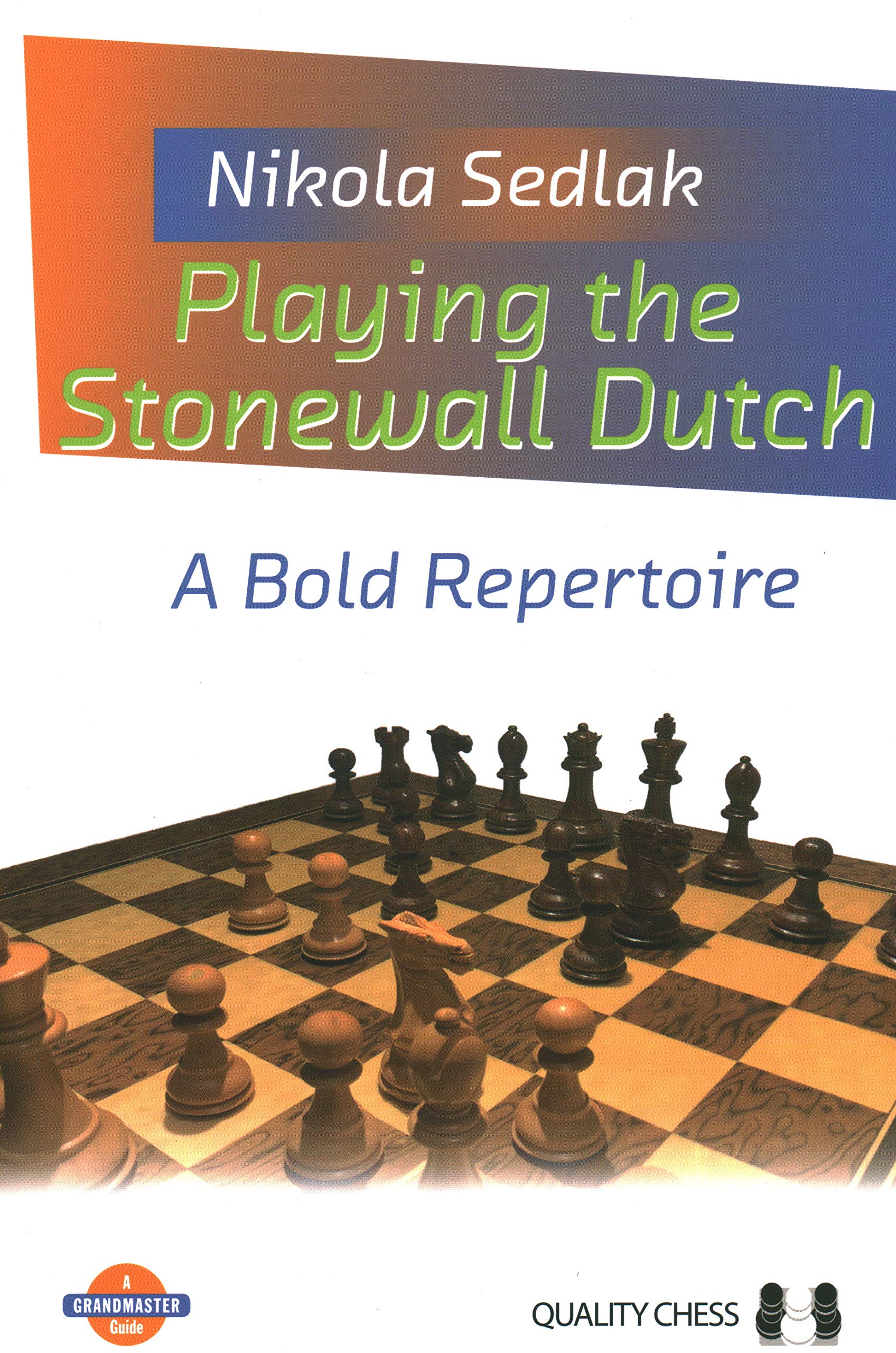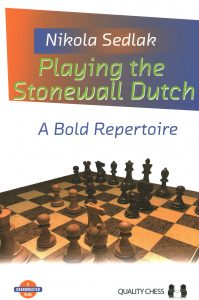
GM Nikola Sedlak is a former Serbian Champion who has won both the EU Individual Open Championship and an Olympiad gold medal.

From the publisher:
“The Dutch Defense is one of Black’s most combative responses to 1.d4, and the Stonewall is the boldest version of this opening. Black immediately seizes space in the center and clamps down on the e4-square, laying the foundations for a complicated strategic battle. Many players believe the Stonewall to be a substandard opening, naively assuming that the e5-outpost and bad light-squared bishop must give White the advantage.
GM Nikola Sedlak disagrees, and in Playing the Stonewall Dutch he shares the insights that have helped him to rack up a healthy plus score from Black’s side. In addition to providing a complete repertoire in the main lines of the Stonewall, this book also offers useful guidance on dealing with Anti-Dutch variations and various move-order subtleties.”
End of blurb…
High quality paper is used and the printing is clear: excellent glossy paper has been used. The weight of this paper gives the book an even better feel to it!
The book can easily be laid flat next to the board and does not require weights to prevent it from “self-closing” (a particular bugbear of ours !). Each diagram is clear and the instructional text is typeset in two column format, which, we find, enables the reader to maintain their place easily. Figurine algebraic notation is used throughout and the diagrams are placed adjacent to the relevant text.
A small (but insignificant) quibble: the diagrams do not have a “to move” indicator (but they do have coordinates!). There is a full games index which is most welcome. This title is part of the Quality Chess Grandmaster Guide series.
The main content is divided into eleven chapters viz:
- Avoiding the Fianchetto
- Fianchetto with Bf4
- 7.Nbd2 & 7.Ne5
- 7.Nc3
- 7.b3
- 5.Nh3
- The Flexible Stonewall
- The Aggressive Stonewall
- Move Orders
- 1.c4 and 1.Nf3
- Exercises
Before we continue it is confession time…
Prior to reading this book I had little knowledge of the Stonewall Dutch from Black’s perspective although I did look at it briefly when studying the Triangle Variation and the Abrahams (Noteboom) Variation of the Semi-Slav. There are lines where Semi-Slav players have the option of transposing into a Stonewall Dutch and Gerald Abrahams did play this way on occasion. I am more familiar from White’s perspective but, nonetheless, to my chagrin, insufficiently so.
In a previous review I made the comment:
The Stonewall Dutch has not hitherto had many books published about it. Popularised by Botvinnik it has found most support by club players rather than by elite Grandmasters. The well known structure for Black is typically :
arrived at by numerous move orders.
and therefore comparison with this other book will be beneficial to the student.
The authors recommended move order of 1.d4 e6 clearly requires Black to be familiar with the French Defence (or the Franco-Sicilian as a matter of taste.) and is a very common mechanism among practitioners of the Classic / Stonewall Dutch. Lenningrad Dutch players have less flexibility at their disposal. 1…e6 has the virtue of avoiding some of White’s pesky so-called Anti-Dutch ideas such as 2. Bg5, 2.Nc3 and the Staunton Gambit (2.e4).
However, for completeness, the author provides ideas for Black to combat the above (and more) white tries after 1.d4 f5 in Chapter 9. In fact, the coverage of these move two tries is more comprehensive than most books on any line of the Dutch Defence.
Consulting Megabase 2020 we find that the author, Nikola Sedlak has recorded 2102 games which ranks him as one of the most active players. We find that against 1. d4 nowadays he plays both 1…f5 and 1…e6 with the latter being the modern move order choice. The Stonewall features in many of these games.
Apart from the move two alternatives I was curious to see the recommendations for dealing with the overly ubiquitous London System. Indeed, against the Stonewall and Classical Dutch is one of the rare occasions where I would consider playing
and 3.Bf4 is only eclipsed (as you’d expect) by 3.c4 or 3.g3 in popularity. There is extensive coverage in Chapter 9 of this club player favourite.
Before delving deeper it is worth knowing that Quality Chess have provided a pdf excerpt of the Preface and and the first twenty or so pages of Chapter 5 on 7.b3. This will give you an excellent feel for the style of presentation so please take a look!
The Introduction chapter is 13 pages of invaluable discussion of the overall strategy of the Stonewall structure interspersed with plans, strategic ideas, themes and motifs. Re-reading until you fully understand these ideas will be time well spent.
Each main content chapter comprises of a schematic of variations followed by a detailed introduction to the ideas and then a number of high quality model games many of which have the author playing the black pieces.
The analysis and recommendations are generous with explanations not spoilt by reams of tedious engine dumps. On average each page contains 3-4 diagrams giving the content a user friendly feel. It is clear that the author does his best to keep the reader engaged and “on-side”: this is not always easy for opening books which are generally harder work to stay with than say games collections or tactics primers.
As I mentioned earlier, my knowledge of the “main” lines (those where white plays g3) is superficial so I decided to conduct a “gedanken” experiment and use MegaBase 2020. Using the “most games” style of lookup I arrived at the following position to have been played the most up to 2020:
giving white a range of 7th move choices. Note that Black has opted for the more active …d6 development of the bishop as against the more conservative …e7. There is a considerable body of theory for both options.
By a considerably large margin the most popular move here is 7.b3:
and MegaBase 2020 has roughly 4,500 games between players of any strength and 1,000 games if you use the “Top Games” option. The author dedicates Chapter 5 and a full 40 pages to 7.b3. (The Pavlovic book also dedicates substantial space to this line.)
So having arrived here I asked Megabase 2020 to show me the most popular direction of travel from here :
7…Qe7; 8.Bb2, 0-0;9.Nbd2,b6;10.Ne5, Bb7;11.Rc1,a5; (various move orders are available as the saying goes) and then White is less clear about the next most popular move although 12.e3 is the standard recommendation.
Consulting the author we find ourselves in Chapter 5, variation B2), page 134 and the variation is considered over six pages in considerable depth. (Pavlovic also covers this position as you would expect.)
The first model game of this chapter to enjoy is this gem:
which is analysed in depth.
Unlike some reviewers I will not be revealing a list of spoilers of what the author recommends in positions x, y and z. Usually I like to point out important lines that have been missed out but I get the impression that coverage is comprehensive and devoid of such omissions.
The overall impression is of a superbly produced book suitable for someone considering adding the Stonewall Dutch to their repertoire as well as an excellent booster for someone who is experienced with it.
Highly recommended!
John Upham, Cove, Hampshire, 15th April, 2021

Book Details :
- Paperback : 328 pages
- Publisher: Quality Chess UK LLP (15 July 2020)
- Language: English
- ISBN-10: 1784831093
- ISBN-13: 978-1784831097
- Product Dimensions: 17.17 x 1.6 x 24.28 cm
Official web site of Quality Chess

